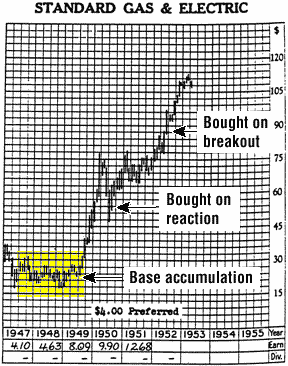WAR STORY
A Cautionary Tale
The Chartist
by Edwin Polokoff
Charts don't lie, just in case you needed a reminder.
I shall never forget George. When I first met him, he was a man in his late 50s, somewhat paunchy, of medium height, dark hair streaked with gray, silver-rimmed glasses shielding tired eyes -- George looked docile. A closer look betrayed his seemingly easygoing manner. His hands shook slightly but uncontrollably, especially when he ate or wrote. My conclusion was that he had been through too many stock market wars, and the wear and tear on his nerves, stress from his occupation, had created the nerve problem.

FIGURE 1: STANDARD GAS & ELECTRIC. George the chartist paid no attention to the talk about this company, instead following its movements and buying it when his technique indicated he should.
George was a professional speculator, a broker with one account -- the
family account. He lived constantly on the edge of great wealth or imminent
poverty. His patrician bearing suggested good breeding, a Park Avenue childhood.
How surprised his acquaintances at the country club would have been if
they had known this quiet, solicitous man, who could pass for a philosophy
instructor at a university, could be such a ferocious gambler.
In those early days, since I often worked late doing my research and planning, I became familiar with George and his theories and modus operandi. With the office mostly deserted by late afternoon, George would occasionally chat with me, lecture me on his techniques. I can still see his figure hunched over the desk, his meticulous, patterned routine of making penciled entries on each of his 100 separate pages of charts in a big binder.
George was a chartist. The charts were his bible; no need to know economics or business or financial analysis. He would say that the chart on each security he followed was the composite of all of the thinking and information available. Chart skill involved interpreting the hieroglyphics in order to discover investment opportunities. While I will not burden you with George's attempts to teach me, I will tell you that much of his theory made sense; he was adept at his craft, but I trusted fundamental analysis over chart interpretations. When George would turn to me and say, "I know nothing about the stock market or individual companies, but my charts know everything," I would smile. Was he serious or was he pulling my leg?
I learned that he had once owned a seat on the New York Stock Exchange, made a fortune, and then lost it in 1929. I felt sorry for him; I wanted so much he would make one more big hit in order to restore his financial health. I did not want him to live the rest of his life trading stocks in order to make a living. Maybe his shaking would stop if he could retire with a decent stake.
Edwin Polokoff is a retired first vice president of Merrill Lynch residing in Florida.
Excerpted from an article originally published in the February 2001 issue of Technical Analysis of STOCKS & COMMODITIES magazine. All rights reserved. © Copyright 2001, Technical Analysis, Inc.
Return to February 2001 Contents